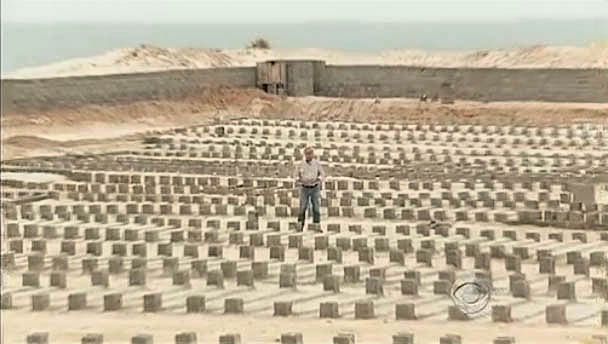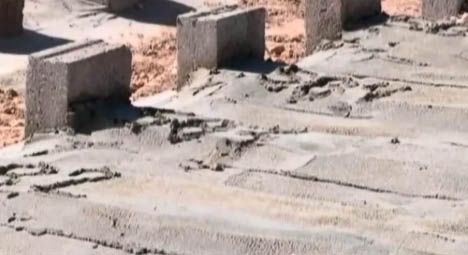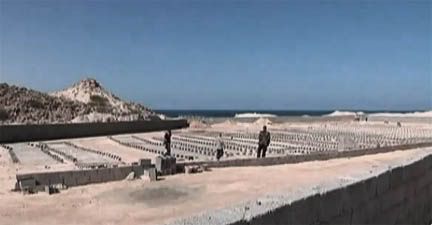last update Nov. 14
Up to 1,000 Nameless Dead
Following the unsurprising torture and murder, following capture, of Libyan leader Muammar Gaddafi (and his brave son Mutassim), there was much talk of what to do with their bodies. The father's was famously displayed half-naked in a Misrata freezer, where locals were able to curse it. A sickly bin-Laden-like secret burial in the desert was selected, apparently for both of them. But before that, National Post reported on October 24:
Gaddafi’s tribe, centred on the city of Sirte where he made his last stand, has asked for the body so they can bury it there. Gaddafi requested to be buried in Sirte in his will.That's just cold, unnamed official. The beach side cemetery for loyalists was extant and reported on since May, had grown to well over 800, as reported in mid-September), nearly all of them unidentified. David Enders reported (above link):
”There are different views,“ said an NTC official in Misrata. ”Some people want them buried in the invaders’ cemetery in Misrata,“ he said, referring to a place outside the city near the sea where hundreds of fallen Gaddafi fighters have been buried with some dignity and respect.
”Some people want to hand them over to his tribe, but we have some demands. Many people have been kidnapped and killed by people in Sirte since the 1980s. We asked them to give those bodies back. Since then they have been quiet,“ said the official who asked not to be named.
The majority of the more than 800 bodies and sets of remains in the "pro-Gadhafi" cemetery are without names or identification other than digital photos of their faces taken by the volunteers who run the cemetery. Many of the bodies have simply been left at the cemetery by the rebels to be buried, with no information about where they were killed or found.They didn't even have identifying paperwork? Apparently some did - the article cited one relative who had just been informed of his brother's internment as "body number 531."
Five months ago (May 21), the BBC's Andrew Harding filed of his meeting with a rebel sheikh named Abu Grain. He was running a prison for former Gaddafi people who'd seen the light, as well as the newly-created loyalist cemetery.
The sheikh escorts us out. He wants to show us the new cemetery that has been built in the sand dunes close to the nearby beach. Once again he appears to be in charge of the project, which caters specifically for the bodies of dead Gaddafi soldiers.Reference to this place continues through the months, and the numbers grow to 800 and perhaps a thousand by now. All along the way, however, "Invaders' Cemetery" doesn't seem to appear as a term describing it until the official's statement of October 24 (at least I didn't see any earlier references pop up right away).
On a North African coastline dotted with the graveyards of earlier conflicts - at places like El Alamein and Tobruk - there are more than 300 graves here, in 10 meandering rows, each covered in a thin layer of cement and pointing towards Mecca.
"These are our brothers and sons. They weren't born our enemies. Gaddafi hid the truth from them," says Sheikh Abu Grain.
And then the same name was first widely reported, by Reuters and CBS, on the following day, in reference to an apparently different locale.
The Invaders' Cemetery Revealed
The first I heard of this was a report from Allen Pizzey, CBS News, Oct. 25, on a site I at first thought was in Sirte, since the other mass grave he reported on (of nearly 300 mysteriously executed people) was there. But as we'll see below, it's near Misrata.
There are no names in one graveyard, only numbers: 572 so far and counting. That's because the graves hold the bodies of alleged mercenaries. Most were killed in the fighting, but local officials freely admit that some were summarily executed.
The governor of a prison in Misrata thinks that amounted to justice.
"There was no mercy for foreign mercenaries," Sheikh Fathie Dariez said.
 |
| Allen Pizzey, for CBS News, stands amidst the 572 graves at the "Invaders' Cemetery." |
As usual, one wonders about the standards employed before deciding who to deny humanity to as a mercenary; their record so far has been none too good. The lack of names suggests either these mercs had no identification with them (and thus could hardly be proven to be foreign fighters), or else these have been hidden in an attempt to fudge the truth of who all is buried here. Judging by observations elsewhere, there are surely very many executed prisoners in there, probably a few dozen severed heads, and other horrors, the clues of which are decaying away into the sand and the sea.
And this is where they wanted to dump the Gaddafis?
Although it looks similar, this seems to be distinct from the above-described Loyalist cemetery. It seems to have a different manager, has only 572 graves as opposed to 800-1,000, and had different specified internees. Then (or perhaps before) Reuters reported on the same place by the same name, the same day. It shows children being shown the graves of "people who tried to kill them, and destroy their will." Here, it's said those buried here are "those who locals say were mercenaries, and Gaddafi loyalists."

Reuters reported on the same day CBS reported 572 graves there. and showed some graves close-up. The numbers here are fingered into the cement atop each grave, in Arabic numbers ("Indian numbers" to Arabs). The high numbers seen include 578, then 582, 583, and 584, with at least two more to the right (see left). The same day as CBS' report, at least 14 additions, it would seem. No number of graves is specified, but its highs mesh with CBS' number intriguingly.
Unless...
The cemetery growing so quickly in October, and likely since the August conquestof Tripoli by racist Misrata brigades, was originally built in May, Reuters added. This would be just about as the other one was started, suggesting possible confusion - on someone's part - between the two.
Reuters' video, panned-out (at right), suggests way more than 586 graves, and it looks a lot like the same one we've heard of. As Harding said, rows of thirty, which seems about right. It's far more than ten rows deep now, suggesting at least 800 graves, to me. In fact, so does the CBS video, looking closer at the above image. (better counts and such, later)
Various views one can find with an image search for Misrata + cemetery + loyalist show about the same thing, blurring together to seem as one, whether it is or not (undecided). A cinderblock wall runs around the seaward side and much of the sides (to block the tide). The inland side open. Graves are wooden frames with dirt bottoms. The quality of the gravesites tends to seem uniform whenever seen, but it changes. Some show numbered wooden slats stuck in sand piles. Others, smooth mounds of concrete with such slats. There are also neat coffin-like concrete tops with cinderblock markers (again here). The last seems to be in effect at the "invaders' cemetery recently, the numbers now inscribed (copied over?) in the (top layer of?) concrete.
Is this all still the same place?
Seashore Shell-Games?
If there's any substance to the notion of a different, smaller, perhaps newer cemetery being opened specifically for mercenaries, I'll fill in this section. That means TWO swelling graveyards getting confused as perhaps one. If it's just a strangely acute misunderstanding, we'll see. Imagery analysis will settle it.
Update November 14:
A reader tipped me off to a Reuters story here at the West African Pilot site describing the Invader's cemetery in Misrata:
Similarly more than 600 graves could be seen marked at the Invaders Cemetery in Misrata on Tuesday. Locals said those buried at the site were mercenaries and loyalists to the former leader Muammar Gaddafi.I've still done no study of the graveyard site(s), but I'm for now presuming this is all the same place. My concern above about the far-off number of graves was unfounded. Closer images clarify that each grave has two cinderblock markers, one at the head and one at the foot. I was estimating somewhat in excessof 1,000 graves, but now see that about 500 or more are shown.
All of the graves were numbered, but some were inscribed with names.
For the people of Misrata who endured more than three months of conflict with Gaddafi forces in March, the cemetery offers a sense of victory.
Was the report of over 800 weeks before this wrong, are there in fact multiple conflated graveyards, or did number in this one go down? Perhaps in some cases relatives were able to re-claim, exhume, and re-inter their loved ones' remains. I'm no fan of the rebel forces' core values, but they're in charge of a country now and its people, and they'd be hard-pressed to find a good reason to refuse helping these families out.
Either way, the number chosen for burial here is arbitrary. Many rebel victims in Sirte, Tripoli, and elsehwere have been blamed on Gaddafi loyalists, claimed as rebel sympathizers, left in the sun for a week, then dumped in mass graves, some later re-discovered and blamed again on the enemy. That there are 600 or 800 slots for those who made it here does not by a long-shot prove that's the number that have been killed, even in that immediate area. The whole point may be to make it seem that way, to finally admit they were killing someone, and to provide a rather low cap on that number, I'd guess set no higher than 50% of the true number.


Your doggedness is quite remarkable; particularly so in light of developments. All that's on offer is the hope that your research may become valuable in the near-term.I fear you will experience disillusionment before then.
ReplyDeleteStill, the human race only proceeds to the drum of it's sentinels.
I can only hope I keep returning until your batteries run out.
godspeed
Thanks for the kind and interesting words, Johd. No worries-the disillusionment set in long ago and I'm used to it by now. :)
ReplyDeleteI will reach a burn-out point eventually and be unable to continue. But interest remains high, and there's much to address and explore, so for the time being I see nothing like that coming up.
the propagsnda YouTube channel, the TruthArmy (sic) showed some crazy footage allegedly from Tripoli from February 22nd, uploaded 25 February, - Mass Graves for Martyrs which shows empty dug graves on the sea coast. But not the one shown above. I guess it was just a stunt for the cameras.
ReplyDeleteThe Al Arabiya video commentary describes the new cemetery as being "close to the main cemetery ,Bin Hammal".... some of the 300 bodies are from the Mahari Hotel,show in the head, hands tied, the interviewee says at about 1.00. (see description under the video).
ReplyDeleteMore from Reuters here at the West African Pilot site describing the Invader's cemetery in Misrata:
Similarly more than 600 graves could be seen marked at the Invaders Cemetery in Misrata on Tuesday. Locals said those buried at the site were mercenaries and loyalists to the former leader Muammar Gaddafi.
All of the graves were numbered, but some were inscribed with names.
For the people of Misrata who endured more than three months of conflict with Gaddafi forces in March, the cemetery offers a sense of victory.
The cemetery lies on the Misrata coastal road and day after day, more visitors are arriving, sometimes with their children, to view rows of graves that they say belonged to people who tried to kill them and destroy their will.
“At the start of the war, there was not a system like this where it was numbered and there was no system. But now they get registered and for those who are unknown, they take photos of them (bodies) and keep it for the time, maybe one day their father or relatives comes looking for them. It is the Islamic way,” said one visitor, a resident of Misrata.
The cemetery was built early in the conflict in May and the bodies of Gaddafi militants have been buried there since.
THanks, Felix. I'll need to start a post for the Sirte mass grave sometime. For the Misrata ones, I'll need to update. I looked again at the images and see where I went wrong.I thought each block represented a grave, but rather it's every two (blocks at the head and foot of each grave).
ReplyDeleteWith that plus this report added, it sounds like 600-ish is the number in the cemetery built in May. Were the 800 reports just exaggerated, or are there now two cemeteries with something like 1,400 bodies? Just 600 sounds pretty small, considering all the fighting in and around Misrata since May...
An old guide book of mine says that the Mahari hotel is 7km west of Sirte on the Tripoli road - quite a way outside the town,54 rooms. Another says only 3km out, close to the sea. I get the feeling that some of these graves are created for propaganda purposes - the one in Zawiya seemed a bit odd to me - quickly dug, some concrete, then bring on the photographers...
ReplyDeleteIt is weird how dead Gaddafi soldiers keep popping up all over Misrata. A quote from The Atlantic
ReplyDeleteLibyan volunteers work to recover and bury dead bodies for health and religious reasons in Misrata, Libya, on May 4, 2011. Misrata doctors estimate that more than 1,000 people have been killed in their city in the two months of fighting between rebels and government forces. Most of the bodies the recovery team finds are soldiers from Qaddafi's regime. "When a fighter gets killed, his friends take his body away," said a team member. He added that Qaddafi's troops didn't seem to do the same.
I am starting to think these dead "soldiers" are not really Libyan but more of the "African mercenary" type. Why else would they leave the bodies behind?
Here is a cemetery in Tripoli:
ReplyDeletehttp://www.flickr.com/photos/fotoinforme/6089899653/
The caption reads:
A view of a cemetery where dead bodies are buried in, after being found in and around the city of Tripoli August 28, 2011. REUTERS/Youssef Boudlal (LIBYA - Tags: CONFLICT MILITARY POLITICS)
An Al Jazeera video, uploaded 26 October 2011, mentions NTC member Mohammed Nasr Al-Harizi - محمد نصر الحريزي - who says nearly 600 bodies were found in Sirte, including the 53 in the Hotel - footage of Hotel, Trench, graves footage of the same cemetery Reuters filmed.
ReplyDeleteHere is a Global Post video with rebel commander Majid al-Fituri discussing the systematic execution of black loyalist captives in Misrata.
ReplyDeleteVideo: One rebel's story
Mirrors:
answers.com
5min.com
Daily Motion